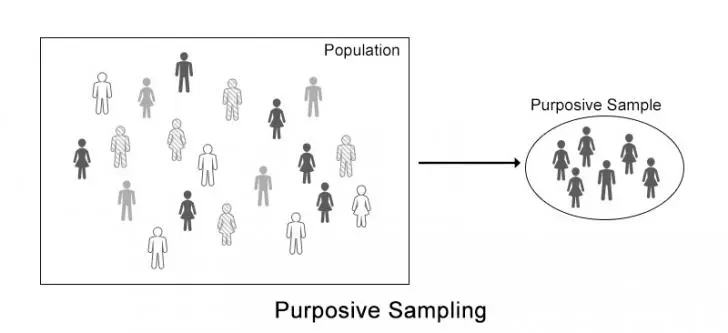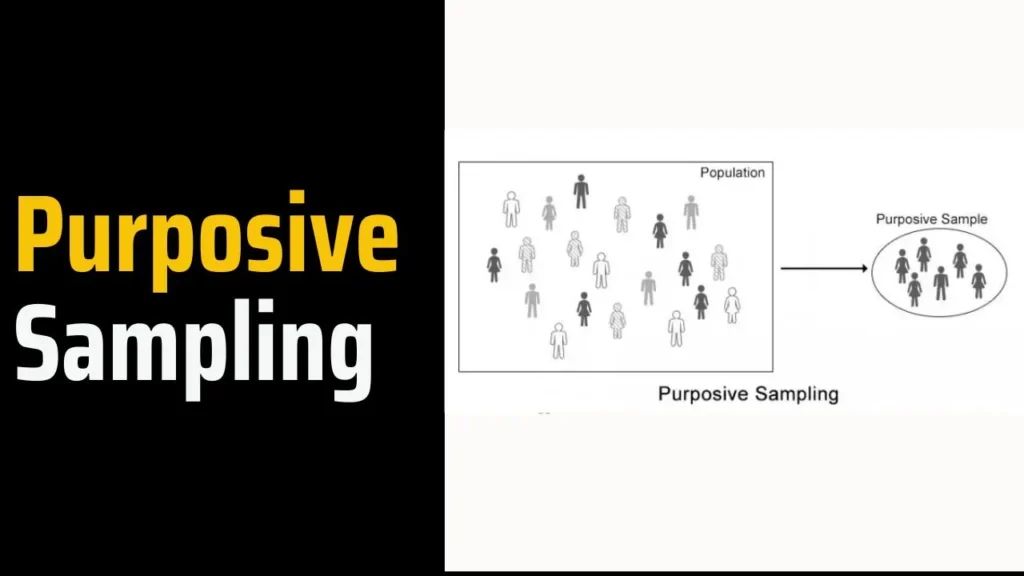Researchers using purposive sampling must possess a prior understanding of their study’s objectives to effectively select and approach suitable participants. The selection criteria align with the needs of the test, survey, or research application.
Purposive Sampling
Purposive sampling, also termed judgmental, selective, or subjective sampling, involves researchers using their own judgment to select participants from a population for a study.
This method, a non-probability sampling method, relies on the researcher’s judgment to choose sample elements. Researchers believe that through careful judgment, they can achieve a representative sample, leading to time and cost savings.
An example of this is TV reporters selectively approaching individuals on the street for opinions on political changes, requiring judgment in choosing whom to interview.
However, it is vital to note that the TV reporter must use some judgement when selecting who to stop on the street to ask questions; otherwise, the technique would be random sampling.
Alternatively, purposive sampling is effective when only a limited number of individuals can provide primary data due to research design and research objectives. For instance, in a study on how personal tragedies like family bereavement impact senior managers’ performance, the researcher may use judgment to select senior managers for in-depth interviews.

Purposive sampling is a method wherein the researcher uses their judgement to select study participants. This type of sampling is not based on probability and is alternatively known as judgmental or expert sampling.
A purposive sample is a subset of the population that is deliberately chosen, usually smaller in size, to logically represent the larger population. This selection is made by considering the background of the population and choosing a sample that reflects its diverse characteristics.
Researchers use sampling techniques when they need to target a specific group of individuals, ensuring that all survey participants are chosen to match a predefined profile.
Example of Purposive Sampling
In an educational research context, purposive sampling might involve selecting top-performing students to gather feedback on pedagogical methods. These students are chosen for their ability to offer valuable insights systematic investigation.
Another example is if your research objective is to analyze how global IT consulting firms in the US utilize social media. Instead of using random sampling, which may not guarantee availability, purposive sampling allows you to select companies that are both accessible and willing to participate, ensuring compatibility with the study’s objectives.
Purposive sampling: why is it used?
Purposive sampling is a random sampling technique aimed at specific attributes within a sample group. It’s effective across various populations but particularly suitable for smaller, more homogeneous groups. This method allows thorough analysis of all data.
Researchers can create an accurate and cost-effective sample by selecting individuals or points based on their expertise.
It facilitates the collection of qualitative response data, leading to a deeper understanding of a topic with precise results.
Unlike random sampling, purposive sampling lacks randomness but is highly accurate and relevant in research, surveys, or experiments.
It simplifies targeting project-specific demographics and maintains a low margin of error due to precise selection based on relevant qualities.
This method is ideal for finding data averages.
Purposive sampling, leveraging participants’ specific knowledge, can yield substantial real-time results in research.
When to use Purposive sampling?
Purposive sampling is best suited for in-depth analysis of small samples. Perhaps you are investigating a topic that is likely to contain unusual cases, or you would like to reach a certain subset of the population that shares specific traits.
The primary objective of purposive sampling is to identify the cases, people, or communities most appropriate to assist you in addressing your research question. Purposive sampling is therefore most effective when you have lots of prior knowledge regarding the research topic. Your sample will be of higher quality the more information you have.
This method is particularly useful in the following scenarios:
- When dealing with a small population.
- For studying a specific subgroup within a larger population.
- When investigating a rare or uncommon phenomenon.
Advantages of purposive sampling
Purposive sampling offers several advantages in research:
- Representative sample: Enables researchers to select a sample that accurately represents specific characteristics or attributes of interest, especially useful for smaller populations or specific subgroups.
- Cost-effective: Generally, less expensive than random sampling methods, contributing to cost savings in research endeavors.
- In-depth data: Commonly used in qualitative research, allowing for detailed data collection on specific topics, leading to deeper insights and understanding of research question.
- Flexibility: It provides flexibility in sample selection, making it suitable for studying rare or unusual phenomena where specific criteria are essential.
- Practicality: Efficient and practical when compared to alternative sampling techniques, especially for small-scale studies with limited sample sizes.
Disadvantages of purposive sampling
Purposive sampling comes with several disadvantages that researchers should be aware of:
- Limited generalizability: Since the sample is not randomly selected, the findings may not apply to the larger population, leading to potential biases and incomplete representations of certain subgroups.
Another risk is the production of lop-sided research, where certain subgroups are omitted or excluded, potentially skewing the results. - Ethical considerations: The researcher is responsible for making sure that the study is carried out ethically and that the participants’ rights are protected. This may necessitate gaining informed consent from participants in the sample and protecting their privacy.
- Bias: Purposive sampling is subjective and based on the researcher’s judgement, which may bring bias into the study. Unintentionally choosing participants or units that match the researcher’s expectations or preconceptions may have an impact on the validity of the study. Additionally, participants can manipulate the insights they provide.
- Limited sample size: Purposive sampling is often used in small scale studies, which may limit the study’s statistical power and ability to detect significant trends or relationships within the data.
- Sampling error: Because of non-random selection, there’s a higher risk of sampling error, affecting the study’s accuracy and the ability to draw valid conclusions about the population.
Types of Purposive Sampling
- Typical Case Sampling: This method is employed when the researcher wishes to study a phenomenon among the ordinary members of the parent sample. For instance, if a survey aims to understand the impact of inflation on individuals with average or low income, in that case, only average or low-income earners will be selected from the overall sample.
- Maximum Variation Sampling: Also referred to as heterogeneous sampling, this method captures diverse customer perspectives relevant to the study at hand.
- Homogeneous Sampling: In contrast to maximum variation, homogeneous sampling selects a group of individuals with similar characteristics, such as age, gender, background, or occupation. It is commonly used to investigate specific traits, features, or areas of interest.
- Expert Sampling: Expert purposive sampling is used to gather insights from individuals with specialized expertise. This type of sampling is particularly useful in the initial phases of qualitative research design for exploring new areas of interest.
- Extreme Case Sampling: Extreme case purposive sampling focuses on studying outliers that deviate significantly from the norm in a specific phenomenon or trend.
- Critical Case Sampling: Critical case purposive sampling selects a single information-rich case to represent the entire population. By studying this case, researchers aim to uncover insights applicable to other similar cases.
- Total Population Sampling: Total population purposive sampling involves examining or surveying the entire population that shares specific characteristics, such as experience, knowledge, or skills.
Principles of purposive sampling
The principles of purposive sampling encompass several key aspects crucial for its effective implementation in research:
- Clearly defined purpose: The study’s purpose must be well-defined, and the sample should be chosen based on specific characteristics or attributes relevant to the research objectives.
- Expertise: It’s essential to have expertise in the research topic when selecting the sample. A deep understanding of the characteristics being studied ensures that the sample is truly representative of the population of interest.
- Bias awareness: Non-random sampling methods can introduce biases, so researchers must be aware of potential biases and take measures to minimize them during sample selection.
- Representative sample: The sample selected should accurately represent the characteristics or attributes under investigation. This ensures that the findings can be generalized to the larger population.
How is purposive sampling conducted?
The process of conducting a study using purposive sampling can vary based on the research topic and the preferences of the researchers. However, there are generally five steps involved in purposive sampling:
- Define the purpose: Clearly outline the study’s objectives and the specific attributes or characteristics of the population you want to study.
- Identify the sample: Select individuals or units from the population based on the defined purpose. Use criteria such as expertise, experience, or specific traits relevant to the study.
- Obtain informed consent: Ensure that participants understand the study’s purpose, their role, and any potential risks or benefits before they agree to participate.
- Collect data: Use appropriate research methods, such as interviews, surveys, or observations, to gather data from the selected sample.
- Analyze the data: Once data collection is complete, analyze the information to draw meaningful conclusions and insights related to the study’s objectives.
Conclusion
Purposive sampling depends on having access to individuals within a population who can offer valuable data. However, if researchers struggle to find enough suitable participants, this method can become time-consuming and resource-intensive. Its goal is to gather a diverse range of participants who meet predefined criteria, enriching the project’s insights.
What type of research uses purposive sampling?
Purposive sampling is commonly utilized in qualitative research for its ability to gather detailed data on specific subjects or areas. It’s also applicable in smaller studies with constrained sample sizes.
What sample size is suitable for purposive sampling?
The sample size for purposive sampling will be determined by the research question and the characteristics or attributes that the researcher want to investigate. For qualitative research, a sample size of thirty people usually is considered sufficient; but, in some cases, larger sample sizes of one hundred or more may be required.



